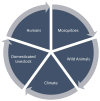Rift Valley Fever
- PMID: 28457351
- PMCID: PMC5458783
- DOI: 10.1016/j.cll.2017.01.004
Rift Valley Fever
Abstract
Rift Valley fever (RVF) is a severe veterinary disease of livestock that also causes moderate to severe illness in people. The life cycle of RVF is complex and involves mosquitoes, livestock, people, and the environment. RVF virus is transmitted from either mosquitoes or farm animals to humans, but is generally not transmitted from person to person. People can develop different diseases after infection, including febrile illness, ocular disease, hemorrhagic fever, or encephalitis. There is a significant risk for emergence of RVF into new locations, which would affect human health and livestock industries.
Keywords: Mosquitos; Rift Valley fever; Transmission; Treatment.
Copyright © 2017 Elsevier Inc. All rights reserved.
Figures


References
-
- World Organization for Animal Health (OIE) [Accessed 24 Aug, 2016];OIE-Listed diseases, infections and infestations in force in 2016. http://www.oie.int/en/animal-health-in-the-world/oie-listed-diseases-2016/
-
- Daubney R, Hudson JR. Enzootic hepatitis or Rift Valley Fever: an undescribed virus disease of sheep, cattle, and man from east Africa. J Path Bact. 1931;34:545–579.
-
- Chevalier V, Pepin M, Plee L, Lancelot R. Rift Valley fever--a threat for Europe? Euro surveillance: European communicable disease bulletin. 2010 Mar 11;15(10):19506. - PubMed
Publication types
MeSH terms
Substances
Grants and funding
LinkOut - more resources
Full Text Sources
Other Literature Sources

